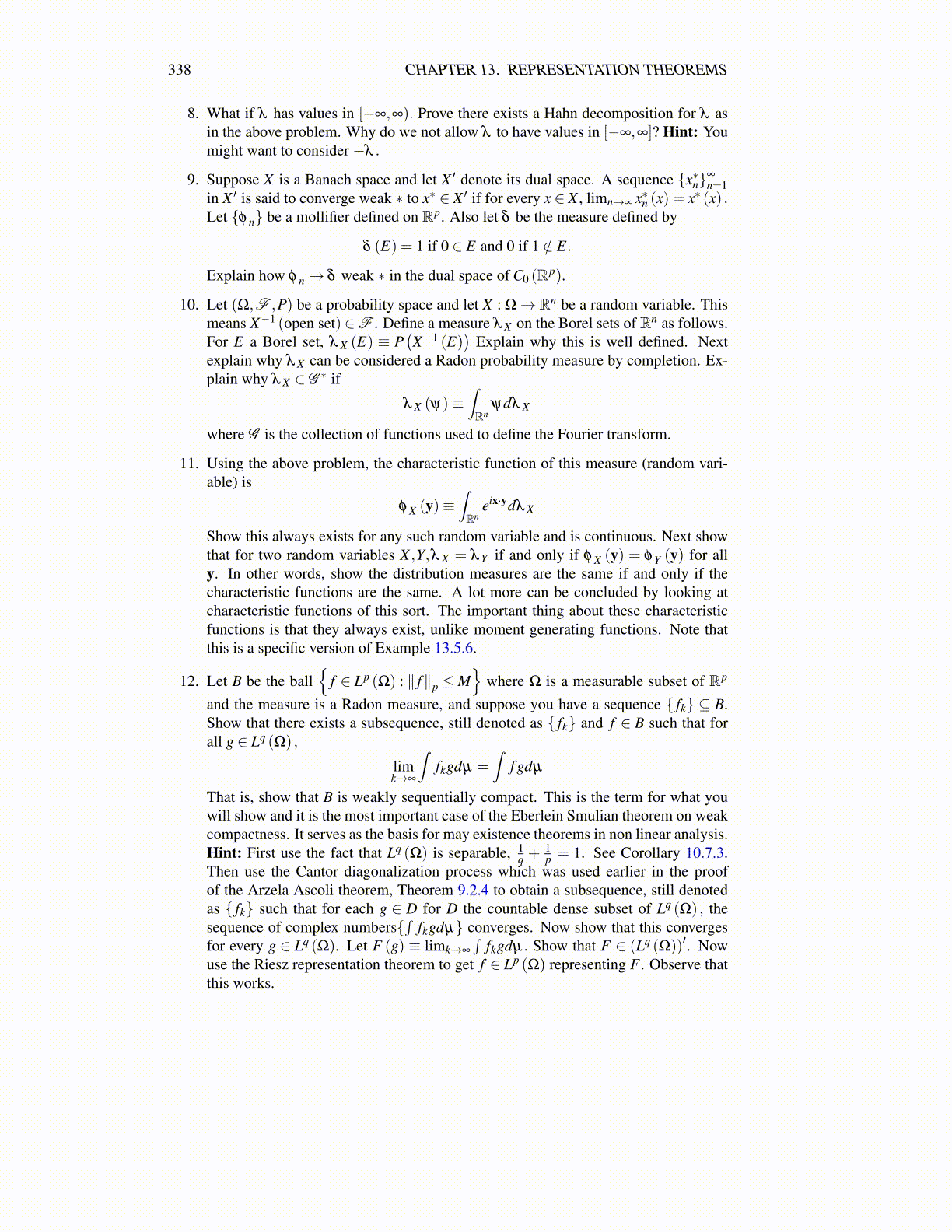
338 CHAPTER 13. REPRESENTATION THEOREMS
8. What if λ has values in [−∞,∞). Prove there exists a Hahn decomposition for λ asin the above problem. Why do we not allow λ to have values in [−∞,∞]? Hint: Youmight want to consider −λ .
9. Suppose X is a Banach space and let X ′ denote its dual space. A sequence {x∗n}∞
n=1in X ′ is said to converge weak ∗ to x∗ ∈ X ′ if for every x ∈ X , limn→∞ x∗n (x) = x∗ (x) .Let {φ n} be a mollifier defined on Rp. Also let δ be the measure defined by
δ (E) = 1 if 0 ∈ E and 0 if 1 /∈ E.
Explain how φ n→ δ weak ∗ in the dual space of C0 (Rp).
10. Let (Ω,F ,P) be a probability space and let X : Ω→ Rn be a random variable. Thismeans X−1 (open set) ∈F . Define a measure λ X on the Borel sets of Rn as follows.For E a Borel set, λ X (E) ≡ P
(X−1 (E)
)Explain why this is well defined. Next
explain why λ X can be considered a Radon probability measure by completion. Ex-plain why λ X ∈ G ∗ if
λ X (ψ)≡∫Rn
ψdλ X
where G is the collection of functions used to define the Fourier transform.
11. Using the above problem, the characteristic function of this measure (random vari-able) is
φ X (y)≡∫Rn
eix·ydλ X
Show this always exists for any such random variable and is continuous. Next showthat for two random variables X ,Y,λ X = λY if and only if φ X (y) = φY (y) for ally. In other words, show the distribution measures are the same if and only if thecharacteristic functions are the same. A lot more can be concluded by looking atcharacteristic functions of this sort. The important thing about these characteristicfunctions is that they always exist, unlike moment generating functions. Note thatthis is a specific version of Example 13.5.6.
12. Let B be the ball{
f ∈ Lp (Ω) : ∥ f∥p ≤M}
where Ω is a measurable subset of Rp
and the measure is a Radon measure, and suppose you have a sequence { fk} ⊆ B.Show that there exists a subsequence, still denoted as { fk} and f ∈ B such that forall g ∈ Lq (Ω) ,
limk→∞
∫fkgdµ =
∫f gdµ
That is, show that B is weakly sequentially compact. This is the term for what youwill show and it is the most important case of the Eberlein Smulian theorem on weakcompactness. It serves as the basis for may existence theorems in non linear analysis.Hint: First use the fact that Lq (Ω) is separable, 1
q +1p = 1. See Corollary 10.7.3.
Then use the Cantor diagonalization process which was used earlier in the proofof the Arzela Ascoli theorem, Theorem 9.2.4 to obtain a subsequence, still denotedas { fk} such that for each g ∈ D for D the countable dense subset of Lq (Ω) , thesequence of complex numbers{
∫fkgdµ} converges. Now show that this converges
for every g ∈ Lq (Ω). Let F (g) ≡ limk→∞
∫fkgdµ. Show that F ∈ (Lq (Ω))′. Now
use the Riesz representation theorem to get f ∈ Lp (Ω) representing F . Observe thatthis works.